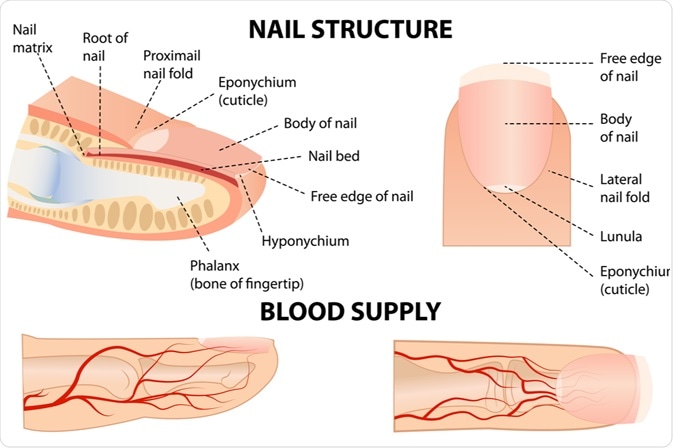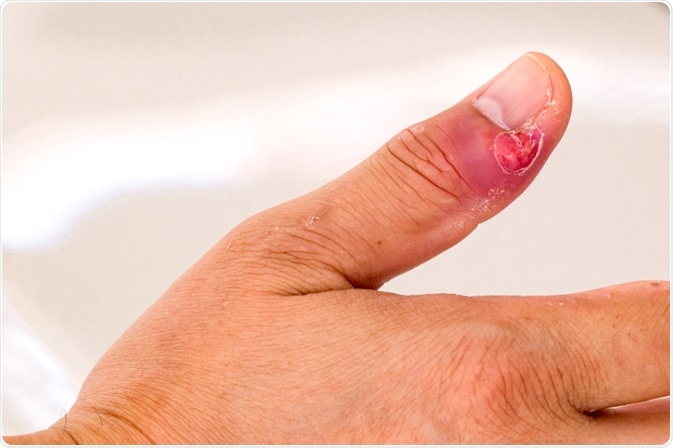Nail fold infections are best understood by considering the anatomy of the nail.

Image Credit: La vector / Shutterstock.com
The nail is composed of a keratinized nail plate that lies over a vascular nail bed. The nail plate keratin is formed by the germinal nail matrix, which is located at the proximal end of the nail bed.
The nail plate is enclosed at its base by the proximal nail fold, and by the lateral nail folds at both sides. The proximal nail fold has two layers; the upper layer is located above the nail plate and the lower layer can be found below this upper layer.
The upper layer continues as the cuticle, binding the nail plate firmly and impenetrably to the skin located behind it. This cuticular seal prevents moisture and microbes from entering the space that may exist between the nail plate and the nail fold.
Causes of nail fold infection
A nail fold infection, which is also referred to as paronychia, is a common condition that occurs when the skin fold at the proximal end of the nail is invaded by bacteria, such as Staphylococcus aureus. Risk factors for such an infection include:
- Constant exposure to moisture
- Cutting back the cuticles too much
- Biting the nails
- The presence of any inflammatory or allergic skin conditions near the nails
Such processes either cause trauma to the skin or reduce the effectiveness of the normal skin barrier to protect itself against microbial invasion.
Individuals whose occupations require them to spend much time with their hands in water and/or exposed to detergents or other chemicals are at a higher risk of developing nail fold infections. Some examples of such occupations include bartenders, janitors, homemakers and housemaids, and dishwashers.
The presence of constant moisture damages the skin and makes it easy to tear or puncture, thereby allowing microorganisms to more easily enter. In addition, moisture encourages the growth of fungi, thus leading to fungal infection of the nail and the nail bed.
Injury to the nail bed or the skin near the nails also breaks down the natural defenses offered by the skin and increases the likelihood of infection. This is particularly true if the person is immunocompromised or diabetic. Thus, biting or tearing off a hangnail is often associated with the development of paronychia because of the extension of the tear into healthy skin or into the nail bed, which predisposes one to infection.

Image Credit: kckate16 / Shutterstock.com
Nail-biting offers special conditions for infections of the nail folds because it not only produces trauma but also introduces bacteria from the mouth into the wound. This includes staphylococcus, streptococcus, Pseudomonas, and Gram-negative bacteria, as well as various fungal organisms.
Eczema of the skin around the fingernails is also an invitation for secondary fungal or bacterial infections because of the broken skin and moist conditions.
Constantly covering the nails is also bad for nail health. For instance, using sculptured (artificial) nails over natural nails cuts off the circulation of air from the area around the nails, which can encourage infection in this area. Similarly, the prolonged use of plastic or vinyl gloves can trap moisture and restrict air entry around the nails, thereby increasing an individual's susceptibility to nail fold infections.
Progress of infection
Once the infection has become established, it often produces pus. The pus can form a pocket, called an abscess. In other cases, the pus may spread around the nail to produce other abscesses at the side of the nail. Pus may also creep under the nail plate to form more pus between the nail bed and the nail plate, thus separating the two altogether or in part. In other patients, secondary fungal infections occur because of this extensive inflammatory response.
As the nail fold infection becomes more chronic, it gives rise to altered growth of the nail plate. This results in thickening or discoloration, or the formation of ridges and depressions on the nail. Other nails may also become infected by the spread of the organism(s) to other fingers.
References
Further Reading
Last Updated: May 7, 2021